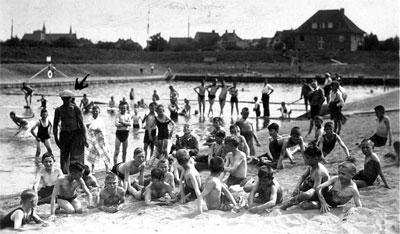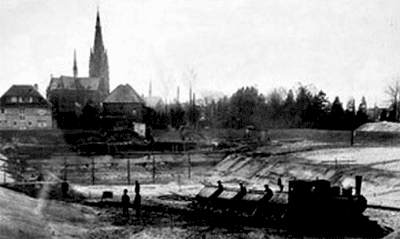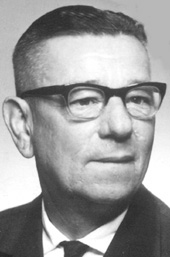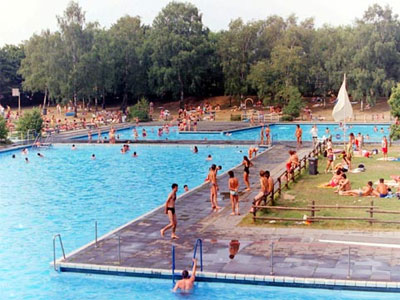The following texts and photos were kindly provided by the Blattus Martinus, the Kevelaer encyclopedia in the net. At this point again many thanks.

A precursor outdoor pool existed at the end of the 19th century on Schravelen behind the mill wheel of the oil mill of Neles Bros. Admission to this public, privately operated outdoor pool cost 25 pfenning. Subscription tickets were sold for 3 marks.

A precursor outdoor pool existed at the end of the 19th century on Schravelen behind the mill wheel of the oil mill of Neles Bros. Admission to this public, privately operated outdoor pool cost 25 pfenning. Subscription tickets were sold for 3 marks.
The swimming enthusiasts in Kevelaer, however, preferred to swim in the Niers and founded the Kevelaer Swimming Club in 1911. However, because the small river was becoming increasingly polluted, this "natural open-air swimming pool" also had only a short life. The swimming club soon disbanded after the baths were discontinued.
In 1928, at the urging of the TuS Kevelaer , the municipality began construction of the outdoor pool on Dondertstraße.

In 1929, the Kevelaer company Quick graveled the basin for the future outdoor pool. The water of the natural pool, which opened in June 1929, was constantly renewed by the Dondert brook, which flowed through the basin. (Photo: Karl-Heinz Quick)

In 1929, the Kevelaer company Quick graveled the basin for the future outdoor pool. The water of the natural pool, which opened in June 1929, was constantly renewed by the Dondert brook, which flowed through the basin. (Photo: Karl-Heinz Quick)
The outdoor swimming pool, which had become unusable due to the effects of war, was desilted in 1947 and reopened to visitors. Later, the "bathing pond" was enclosed with concrete walls. In the muddy bottom lived, as was discovered during a clean-up operation, exceedingly many and large eels.

The first lifeguard was Michael Gey, who founded the TuS swimming department with Franz Douteil in the founding year. Generations were teached how to swim by him. After the Second World War, the Gey family leased the entire outdoor pool on the Dondert from the city. The certified blacksmith and locksmith was able to manage the repair work himself. At that time, the city had no money to maintain and operate the pool. At the Dondert, Michael Gey taught Kevelaer's students how to swim. Even at the age of almost 80, Michel Gey was still able to perform an Auerbach somersault from the 3-meter board. His son Gottfried took over his father's job from 1964 to 1984.

The first lifeguard was Michael Gey, who founded the TuS swimming department with Franz Douteil in the founding year. Generations were teached how to swim by him. After the Second World War, the Gey family leased the entire outdoor pool on the Dondert from the city. The certified blacksmith and locksmith was able to manage the repair work himself. At that time, the city had no money to maintain and operate the pool. At the Dondert, Michael Gey taught Kevelaer's students how to swim. Even at the age of almost 80, Michel Gey was still able to perform an Auerbach somersault from the 3-meter board. His son Gottfried took over his father's job from 1964 to 1984.
In 1962, the Dondert Bath was expanded to 2,000 square meters of water. In 1965, the city enlarged the toilet facilities. In the years that followed, the open-air pool was only ever maintained in a makeshift manner, and the renovation backlog turned it into an oppressive cost factor for the city.
In 1983, the idea of abandoning the open-air pool, selling the land to those willing to build and offering the indoor pool, which was to be expanded, as a replacement was first mooted. However, there was no majority in politics for this.
Instead of abandonment, expansion was now the order of the day. In 1987, the city planned to expand the sunbathing areas. But because the pool liner had become defective and the pressure to renovate was increasing, in 1988 more and more politicians became friends with the idea of abandoning the "Dondert" and building an outdoor pool there as part of an "indoor pool attraction". But before the city could get its act together, the district of Kleve, as the supervisory authority, vetoed the financing concept at the end of 1988. Nevertheless, the council majority rejected the Green Party's proposal to break the deadlock and renovate the outdoor pool on the Dondert.
the city managed to lease meadows for the expansion of the sunbathing areas. Because the city council continued to pursue its plan to add a smaller outdoor pool to the indoor pool, it no longer wanted to invest money in the Dondert pool. Urgently needed repairs were not carried out.

Now they slowly turned their attention back to the traditional swimming pool on the Dondert and calculated that a renovation would cost around two million marks. But nothing came of it, because with the emergence of dreams of a spa center on the Hüls, the city fathers saw a future outdoor pool on the Hüls rather than on the Dondert.

Now they slowly turned their attention back to the traditional swimming pool on the Dondert and calculated that a renovation would cost around two million marks. But nothing came of it, because with the emergence of dreams of a spa center on the Hüls, the city fathers saw a future outdoor pool on the Hüls rather than on the Dondert.
it seemed as if the long wait was over when a government grant of 500,000 marks for the renovation of the open-air swimming pool arrived. But instead of taking the grant and investing an additional 1.5 million marks in the open-air pool, Kevelaer decided to forego the half million from Düsseldorf. Once again, nothing happened.
Then a 1996 crisis team made up of members of various associations sat down and looked for a way out of the messy situation. The friends of the open-air pool collected thousands of signatures and founded the Bäderverein Kevelaer in May 1997, which soon developed into the largest citizens' movement ever to exist in Kevelaer. The Bäderverein took over the management and managed to ensure that the open-air pool was renovated, expanded and beautified step by step - and, above all, preserved.